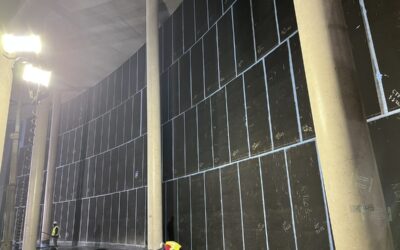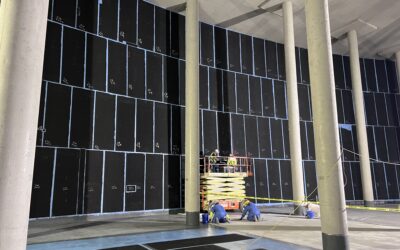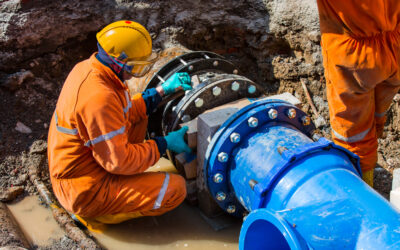In harsh industrial environments like chemical processing plants, mining operations, and water treatment facilities, equipment is constantly exposed to corrosive chemicals and abrasive materials. Rubber lining is a critical protective barrier, shielding tanks, pipes, and vessels from damage and costly downtime.
However, the benefits of rubber lining are only as strong as the quality control behind it. Even the best materials can fail without proper planning, installation, and inspection, leading to leaks, contamination, or even full system shutdowns.
This guide outlines the key steps of rubber lining quality control. These best practices will help ensure long-lasting protection and reliable performance in the field.
5 Steps to Ensuring Rubber Lining Quality Control
Step 1. Surface Preparation: The Foundation of Quality
Proper surface preparation is the foundation of every successful rubber lining application. Cutting corners here can compromise the integrity of the entire job.
Before any rubber can be applied, the surface must be completely clean and ready to bond. This includes:
- Degreasing to remove oils, residues, or contaminants that could interfere with adhesion.
- Abrasive blasting to eliminate rust, mill scale, and old coatings, creating a uniform, roughened surface.
The goal is to achieve the correct anchor profile — the textured surface that allows the rubber lining to grip effectively. If the profile is too smooth or uneven, it increases the risk of delamination, blistering, or premature failure under pressure or chemical exposure.
Disregarding surface prep is one of the most common—and most costly—mistakes in industrial rubber lining. Taking the time to do it right ensures a reliable bond and extends the life of your equipment.
2. Material Selection: Match the Rubber to the Job
Not all rubber linings are created equal, and choosing the wrong one can lead to rapid deterioration, system failure, and expensive rework. To ensure long-term performance, the rubber lining material must be carefully matched to the application’s demands.
Key factors to consider include:
- Chemical exposure – Will the lining be in contact with acids, alkalis, solvents, or other corrosive substances?
- Operating temperature – Can the material handle the thermal conditions of the environment without degrading?
- Abrasion and impact – Is the lining tough enough to withstand heavy wear or aggressive slurry flow?
- Pressure conditions – Will the lining maintain its bond and integrity under constant or fluctuating pressure?
Common rubber lining materials include:
- Natural rubber – Excellent abrasion resistance and elasticity; ideal for wear protection in slurry handling.
- Chlorobutyl – Strong chemical resistance and good heat tolerance; often used in chemical storage tanks.
- Neoprene – Offers moderate chemical resistance and flexibility; a good all-around option for general applications.
Whatever the choice, always verify material certifications to ensure the rubber lining meets the required specifications and standards.
3. Rubber Lining Installation: Best Practices
Once the surface prep is complete and the right material is selected, it’s time for installation. Proper rubber lining installation ensures a uniform, long-lasting barrier that can withstand the rigors of industrial use.
Techniques Matter:
Different lining applications call for different installation methods, including:
- Hand lay-up – Common for on-site or complex geometries; requires attention to detail to ensure complete coverage and proper adhesion.
- Autoclave vulcanization – Used in shop settings for a controlled, high-performance bond through heat and pressure.
- Cold bonding – A chemical cure method that allows flexibility for specific field installations, but demands precise handling and surface conditions.
Regardless of method, quality control hinges on controlling key variables such as:
- Thickness – Consistent across the surface to avoid weak spots.
- Overlaps and joints – Properly staggered and sealed to prevent delamination.
- Edge terminations – Smooth, reinforced edges reduce the risk of peeling or wear at the margins.
Environmental Controls During Application:
Even a flawless application can fail if environmental conditions aren’t monitored. Humidity, temperature, and airborne contaminants can all affect bonding and curing.
Best practices for on-site environmental control include:
- Climate control – Keep temperature and humidity within recommended ranges.
- Dust control and ventilation – Minimize airborne particles that could interfere with adhesion.
- Work timing – Avoid applying linings during shifts in temperature or when conditions fluctuate rapidly.
Maintaining these controls ensures consistent curing and strong adhesion. That’s why environment monitoring should be part of every rubber lining quality control checklist — especially in field applications where conditions are less predictable.
4. Inspection & Testing: Keep Things Safe
Even the most carefully installed rubber lining must undergo thorough inspection and testing to ensure it meets performance and safety standards. Skipping or rushing this step can allow hidden defects to go unnoticed, leading to system failures later on.
Key Inspection Checkpoints:
A comprehensive rubber lining inspection includes multiple checkpoints throughout the process:
- Visual inspection – Identify surface flaws such as wrinkles, bubbles, trapped debris, or edge lifting.
- Spark testing – Detect pinholes or voids in the lining using a high-voltage spark tester.
- Adhesion testing – Verify bond strength between the lining and substrate, typically using pull-off or peel tests.
- Thickness checks – Ensure lining is applied to spec, using gauges to confirm uniformity across the entire surface.
Milestones in the Inspection Process:
To catch issues early, inspections should be staged at critical points:
- Post-application – Confirm proper layout, overlaps, and seam integrity before curing.
- Pre-cure and post-cure testing – Ensure the lining has been applied and cured according to manufacturer guidelines.
- Final quality assurance signoff – Confirm the system is ready for service and fully compliant with project requirements.
What to Look For:
Common defects in rubber lining include:
- Blisters or bubbles – Often caused by trapped air or moisture.
- Voids or holidays – Gaps in coverage that can lead to leaks or chemical exposure.
- Undercure – Incomplete curing of the lining, which can lead to softness, poor adhesion, and premature wear.
Addressing these issues early ensures your rubber lining performs as expected under pressure — literally.
Safety Considerations Throughout the Process:
Inspection and installation both involve hazards that require strict safety protocols. These include:
- PPE – Wear gloves, goggles, and respirators during surface prep, bonding, and inspection.
- Proper handling – Adhesives and curing chemicals may emit fumes or be flammable.
- Extra precautions – Have standby supervision in confined spaces like tanks or vessels.
Integrating safety into every phase of the rubber lining process protects your crew, equipment, and project timeline.
Step 5. Documentation & Traceability: Support Long-Term Performance
Rubber lining quality control doesn’t end with the final inspection. You need to have a clear, traceable record of every step taken. Thorough documentation helps verify compliance with customer and regulatory requirements.
Why Documentation Matters:
When something goes wrong, documentation provides the proof needed to troubleshoot the issue or demonstrate that procedures were followed correctly. It also makes it easier to track material performance over time to plan replacements or repairs.
What to Include:
Effective documentation for rubber lining projects should capture the following:
- Surface prep photos – Visual confirmation that blasting and cleaning were done correctly.
- Material batch numbers – These are used to track product performance or address warranty claims.
- Application details – Dates, installers, methods used, ambient conditions, and cure times.
- Test results – Spark testing logs, adhesion test results, and thickness readings.
- Inspection checklists – Signed by QA personnel to confirm all milestones were completed.
Supporting Long-Term Performance
This level of detail not only protects your project during commissioning — it also supports long-term asset management. When future inspections or repairs are needed, your team will know what materials were used, how they were applied, and what conditions were present during installation.
Quality Control Starts with the Right Partner
When it comes to getting it right, experience matters. At US Rubber, we help industrial operations protect their most valuable assets with expert rubber lining solutions, quality control support, and a commitment to long-term reliability.
Need help with your next rubber lining project? Contact US Rubber to speak with a specialist or request a quote today.








